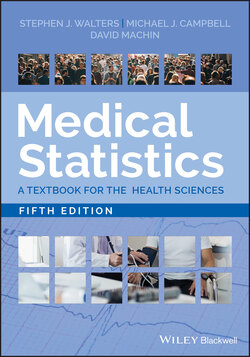Читать книгу Medical Statistics - David Machin - Страница 100
4.2 The Binomial Distribution
ОглавлениеIf a group of patients is given a new treatment such as acupuncture for the relief of a particular condition, such as tension type headache, then the proportion p being successfully treated can be regarded as estimating the population treatment success rate π (here, π denotes a population value and has no connection at all with the mathematical constant 3.14159). The sample proportion p is analogous to the sample mean , in that if we score zero for those s patients who fail on treatment, and unity for those r who succeed, then p = r/n, where n = r + s is the total number of patients treated. The Binomial distribution is characterised by the parameters n (the number of individuals in the sample, or repetitions of the trial) and π (the true probability of success for each individual, or in each trial). The formula is given as Eq. (4.1) in Section 4.9.
For a fixed sample size n the shape of the Binomial distribution depends only on π. Suppose n = 5 patients are to be treated, and it is known that on average 0.25 will respond to this particular treatment. The number of responses actually observed can only take integer values between 0 (no responses) and 5 (all respond). The Binomial distribution for this case is illustrated in Figure 4.4a. The distribution is not symmetric; it has a maximum at one response and the height of the blocks corresponds to the probability of obtaining the particular number of responses from the five patients yet to be treated.
Figure 4.4 Binomial distribution for π = 0.25 and various values of n. The horizontal scale in each diagram shows the value of r the number of successes.
Figure 4.4 illustrates the shape of the Binomial distribution for various n and π = 0.25. When n is small (here 5 and 10), as in Figure 4.4a and b, the distribution is skewed to the right. The distribution becomes more symmetrical as the sample size increases (here 20 and 50) as in Figure 4.4c and d. We also note that the width of the bars decreases as n increases since the total probability of unity is divided amongst more and more possibilities.
If π were set equal to 0.5, then all the distributions corresponding to those of Figure 4.4 would be symmetrical whatever the size of n. On the other hand, if π = 0.75 then the distributions would be skewed to the left.
We can use the properties of the Binomial distribution when making inferences about proportions, as we shall see in subsequent chapters.
